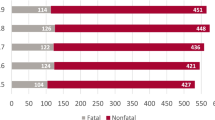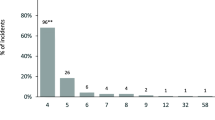Abstract
Studies consistently find that gang members are involved in a disproportionately high rate of violence. The association between gangs and violence is largely based on the legal definition of violence, however. The current study moves beyond the legal definition of gang violence by examining the relationship between non-lethal gang involved incidents and the likelihood of victim injury, using pooled data (1992–2005) from the National Crime Victimization Survey. Overall, results reveal that gang members are not more likely than are non-gang members to injure their victims. When analyses are restricted to incidents involving injury, or incidents involving weapons, gang members are no more likely to more severely injure their victims than non-gang members. Strengths and limitations of the study are discussed.
Similar content being viewed by others
Notes
Victimization surveys available include, but are not limited to, the National Crime Victimization Survey (United States), the British Crime Surveys (England and Wales), the Scottish Crime Survey (Scotland), the International Crime Victimization Survey. In addition, several countries are currently exploring the possibility of implementing a crime survey (e.g., Japan and Mexico).
Twenty-eight cases in which the respondent did not provide information on whether they were or were not injured were dropped from the analyses.
Another option is to measure severity at the ordinal level. For example, injury to the victim could be measured from no injury to minor injury to serious injury. Given this scheme, a proportional odds logistic regression model is suggested (Long 1997; Hosmer and Lemeshow 2000). Proportional odds model compares a single outcome response to one or more reference categories (Hosmer and Lemeshow 2000) and resulting inferences from them lend themselves to a general discussion of direction of response and without a focus on specific outcome categories. While analytically feasible, this approach is not used because analyses (not shown) demonstrate that the assumption of parallel regression is violated.
Analyses were also conducted using an independent variable coded as “0” non-lethal gang violence, “1” non-lethal non-gang violence and “2” unknown gang membership of offender(s). Models using this measurement are statistically and substantively the same as analyses shown. In other words, these findings demonstrate that non-lethal gang violence does not differ significantly from non-lethal, non-gang violence, nor does it differ from non-lethal violence where the gang membership of the offender is not clear.
To further examine this issue, the authors disaggregated the data by offense type (e.g., robbery, assault,…) to determine if the effect of gang membership on victim injury was offense specific. Results revealed that gang membership was not significantly associated with victim injury in any of the disaggregated models.
References
Battin, S., Hill, K. G., Abbott, R., Catalano, R. F., & Hawkins, J. D. (1998). The contribution of gang membership to delinquency beyond delinquent friends. Criminology, 36, 93–115.
Baumer, E. (2002). Neighborhood disadvantage and police notification by victims of violence. Criminology, 40, 579–616.
Bjerregaard, B., & Smith, C. (1993). Gender differences in gang participation, delinquency, and substance use. Journal of Quantitative Criminology, 9, 329–355.
Bjerregaard, B., & Lizotte, A. J. (1995). Gun ownership and gang membership. Journal of Criminal Law and Criminology, 86, 37–58.
Block, C. R., & Block, R. (1993). Street gang crime in Chicago. Washington, DC: U.S. Department of Justice.
Catalano, S. (2006). Criminal victimization, 2005. Washington, DC: U.S. Government Printing Office.
Curry, G. D. (2000). Self-reported gang involvement and officially recorded delinquency. Criminology, 38(4), 1252–1274.
Curry, G. D., Decker, S. H., & Egley, A. J. (2002). Gang involvement and delinquency in a middle school population. Justice Quarterly, 19(2), 275–292.
Curry, G. D., Decker, S. H., & Egley, A. J. (2006). Gang involvement and delinquency in a middle school population. In A. J. Egley, C. L. Maxson, J. Miller, & M. W. Klein (Eds.), The Modern Gang Reader pp. 233–243. Los Angeles, CA: Roxbury Publishing Company.
Decker, S. H. (1996). Collective and normative features of gang violence. Justice Quarterly, 13(2), 243–264.
Decker, S. H., & Van Winkle, B. (1996). Life in the gang. New York: Cambridge University Press.
Esbensen, F. A., & Huizinga, D. (1993). Gangs, drugs, and delinquency in a survey of urban youth. Criminology, 31, 565–589.
Fagan, J. (1990). Social processes of delinquency and drug use among urban gangs. In C. R. Huff (Ed.), Gangs in America pp. 183–219. Newbury Park, CA: Sage Publications.
Gottfredson, M. R. & Hirschi, T. (1990) A general theory of crime. Stanford University Press
Heimer, K. 2000. Changes in the gender gap in crime and women’s economic marginalization, pp. 427–84 in The Nature of Crime: Continuity and Change edited by the National Institute of Justice. Washington, DC: USGPO.
Hindelang, M. J. (1978). Race and involvement in common law personal crimes. American Sociological Review, 43, 93–109.
Hindelang, M. J. (1981). Variations in sex-race-age-specific incidence rates of offending. American Sociological Review, 46, 461–474.
Horowitz, R. (1983). Honor and the American dream. New Brunswick, NJ: Rutgers University Press.
Howell, J. C. (1998). Youth gangs: An overview. Washington, DC: Office of Juvenile Justice and Delinquency Prevention: U.S. Department of Justice.
Howell, J. C., & Decker, S. H. (1999). The youth gangs, drugs, and violence connection. Washington, DC: Office of Juvenile Justice and Delinquency Prevention: U.S. Department of Justice.
Katz, C. M. (2003). Issues in the production and dissemination of gang statistics: An ethnographic study of a large Midwestern police gang unit. Crime and Delinquency, 49(3), 485–516.
Klaus, P., & Rennison, C. M. (2002). Age patterns of violent victimization, 1976–2000. Washington, DC: USGPO. NCJ 190104.
Klein, M. W. (1971). Street gangs and street workers. Englewood Cliffs, NJ: Prentice Hall.
Klein, M. W. (2006). Street gangs: A cross-national perspective. In A. J. Egley, C. L. Maxson, J. Miller, & M. W. Klein (Eds.), The Modern Gang Reader pp. 104–116. Los Angeles, CA: Roxbury Publishing Company.
Lauritsen, J. L., & Rennison, C. M. (2005). The role of race and ethnicity in violence against women. In K. Heimer, & C. Kruttschnitt (Eds.), Gender and Crime1 Patterns in Victimization and Offending. New York: New York University Press.
Lauritsen, J. L., & Schaum, R. (2004). Social ecology of violence against women. Criminology, 42, 323–357.
Levy, P. S., & Lemeshow, S. (1999). Sampling of populations: Methods and applications (3rd Ed.). New York: John Wiley and Sons, Inc.
Lizotte, A. J., Tesoriero, J. M., Thornberry, T. P., & Krohn, M. D. (1994). Patterns of adolescent firearms ownership and use. Justice Quarterly, 11, 51–73.
Maxson, C. L., Gordon, M. A., & Klein, M. W. (1985). Differences between gang and nongang homicides. Criminology, 23(2), 209–222.
Miller, J. (1998). Up it up: Gender and the accomplishment of street robbery. Criminology, 36(1), 37–66.
Planty, M. (2002). Third-party involvement in violent crime, 1993–99. Bureau of Justice Statistics: GPO.
Rennison, C. M. (2002). Hispanic victims of violent crime, 1993–2000/Víctimas Hispanas de Crímenes Violentos, 1993–2000. Washington, DC: USGPO.
Rennison, C. M., & Rand, M. R. (2007). Introduction to the National Crime Victimization Survey. In J. P. Lynch, & L. A. Addington (Eds.), Understanding Crime Statistics1 Revisiting the Divergence of the NCVS and the UCR. Cambridge, UK: Cambridge University Press.
Rennison, C. M., & Rand, M. R. (2003). Criminal victimization 2002. Washington, DC: Bureau of Justice Statistics.
Rennison, C. M., & Welchans, S. (2000). Intimate partner violence. Washington, DC: USGPO.
Rosenfeld, R., & Decker, S. H. (1996). Consent to search and seize: Evaluating an innovative Youth Firearm Suppression Program. Law and Contemporary Problems, 59, 197–220.
Sampson, R. J., & Lauritsen, J. L. (1994). Violent victimization and offending: Individual-, situational-, and community-level risk factors. pp. 1–114. In Understanding and Preventing Violence: Social Influences (Volume 3), edited by Albert J. Reiss, Jr. and Jeffrey Roth. (National Research Council). Washington, D.C.: National Academy Press.
Simpson, S. (1991). Caste, class and violent crime: Explaining difference in female offending. Criminology, 29(1), 115–135.
Sullivan, M. L. (1989). Getting paid: Youth crime and work in the inner city. Ithaca, NY: Cornell University Press.
Thornberry, T. P. (1998). Membership in youth gangs and involvement in serious and violent offending. In R. Loeber, & D. P. Farrington (Eds.), Serious and violent juvenile offenders. Thousand Oaks, CA: Sage.
Thornberry, T. P. (2006). Membership in youth gangs and involvement in serious and violent offending. In A. J. Egley, C. L. Maxson, J. Miller, & M. W. Klein (Eds.), The Modern Gang Reader pp. 224–232. Los Angeles: Roxbury Publishing.
Thornberry, T. P., Krohn, M. D., Lizotte, A. J., & Chard-Wierschem, D. (1993). The role of juvenile gangs in facilitating delinquent behavior. Journal of Research in Crime and Delinquency, 30, 75–85.
Thornberry, T. P., Krohn, M. D., Lizotte, A. J., Smith, C. A., & Tobin, K. (2003). Gangs and delinquency in developmental perspective. New York: Cambridge University Press.
Thrasher, F. (1927). The gang. Chicago: University of Chicago Press.
U.S. Department of Justice, Bureau of Justice Assistance (2004). Project safe neighborhoods: America's network against gun violence. Bureau of Justice Assistance Program Brief. Washington, DC: U.S. Department of Justice.
U.S. Department of Justice (2006). Criminal victimization in the United States, 2005 statistical tables. (No. NCJ 215244). Washington, DC: Bureau of Justice Statistics.
Acknowledgement
The authors would like to thank T.J. Taylor, Brian Payne, and the anonymous reviewers for their helpful comments on earlier versions of this manuscript. We are solely responsible for any errors or omissions that remain.
Author information
Authors and Affiliations
Corresponding author
Rights and permissions
About this article
Cite this article
Melde, C., Rennison, C.M. The Effect of Gang Perpetrated Crime on the Likelihood of Non-Lethal Victim Injury. Am J Crim Just 33, 234–251 (2008). https://doi.org/10.1007/s12103-008-9044-0
Received:
Accepted:
Published:
Issue Date:
DOI: https://doi.org/10.1007/s12103-008-9044-0




